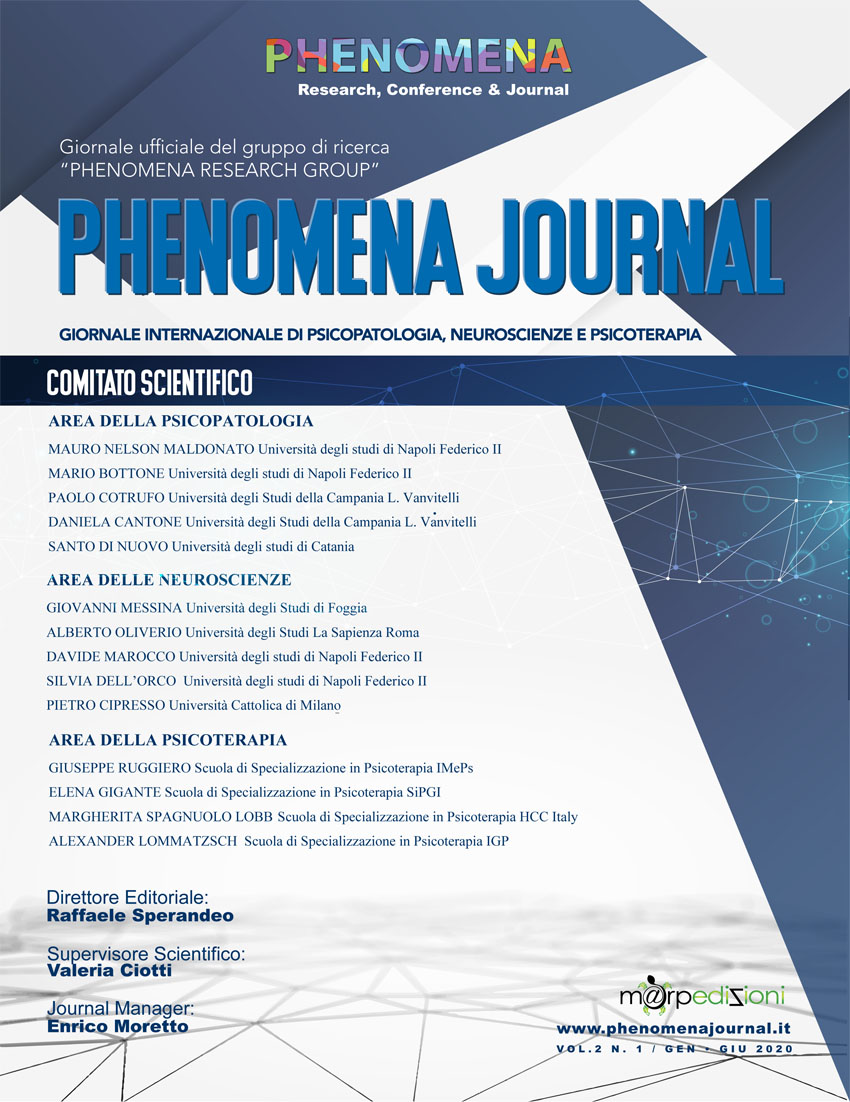La natura dell’amore tra oggettività e soggettività.: Una proposta di ricerca in chiave neurofenomenologica.
Pubblicato 05.06.2020
Come citare
Abstract
Love is an omnipresent phenomenon in the human existence, a central experience that crosses all phases of the life in different ways and it defines itself as the true infrastructure of the human being, creating a field in which the different subjectivities can be identified by growing together.However, what is love? Is it really like Platone says in the myth, a reunion with the other half lost in the world or, as Freud says, is a renunciation of a part of love for the self? But, perhaps, the most interesting and least explored question is: what are the paths of love’s expression? How do we love? To try to partially answer to this question it seems to be necessary to arrive to an empirical study about love, focused on romantic love, which contemplates its complexity and that can understand the dialectic between the intrapsychic and the interpsychic elements, using study parameters that go beyond the prevalent perspective. So, our study is based on the analysis of the subjective experience of love according to the neurophenomenological methodology.
Keywords: love, neurophenomenology, subjectivity.
Abstract in italiano
L’amore è un fenomeno onnipresente e totalizzante nell’esistenza degli esseri umani, una esperienza centrale che attraversa in forme diverse tutte le fasi del ciclo di vita e, nel suo carattere di onnipresenza, esso si definisce come la vera e propria infrastruttura dell’essere creando un campo in cui le diverse soggettività possono individuarsi crescendo insieme. Ma che cos’è l’amore? È realmente come dice Platone nel mito un ricongiungimento all’altra metà dispersa per il mondo o, come dice Freud, è una rinuncia ad una parte dell’amore per il sé? Ma in realtà forse la domanda più interessante e meno esplorata è: quali sono le vie di espressione dell’amore Come amiamo? È necessario giungere ad uno studio empirico dell’amore focalizzato nel presente lavoro sull’amore romantico che tenga conto della sua complessità e che sappia cogliere la dialettica tra gli elementi intrapsichici e quelli interpsichici, utilizzando parametri di studio che esulino dalle considerazioni puramente strumentali che finora hanno avuto spazio in questo campo. In questo senso il nostro studio si basa sull’analisi dell’esperienza soggettiva dell’amore secondo la metodologianeurofenomenologica.
Parole chiave: amore, neurofenomenologia, soggettività
Riferimenti bibliografici
- Ferrari, F. (2013). I miti di Platone. Bur.
- Chalmers, D. J. (1995). Facing up to the problem of consciousness. Journal of consciousness studies, 2(3), 200-219.
- Fromm, E. (1977). Avere o essere. Mondadori Editore, Milano.
- Terrin, A. N. (1993). Per una fenomenologia dell’amore umano. Credere, 78(6), 15-28.
- Freud, S. (2014). On narcissism: an introduction. Read Books Ltd.
- Zeki, S. (2010). Splendori e miserie del cervello. Codice, Torino. Trend: Le guide in un mondo che cambia.
- Bartels, A., & Zeki, S. (2000). The neural basis of romantic love. Neuroreport, 11(17), 3829-3834.
- Walum, H., & Young, L. J. (2018). The neural mechanisms and circuitry of the pair bond. Nature Reviews Neuroscience, 19(11), 643-654.
- Young, L. J., & Wang, Z. (2004). The neurobiology of pair bonding. Nature neuroscience, 7(10), 1048-1054
- Purves, D., Augustine, G. J., Fitzpatrick, D., Hall, W. C., LaMantia, A. S., McNamara, J. O., & White, L. (2014). Neuroscience. De Boeck, Sinauer, Sunderland, Mass, 15-16.
- Bitbol, M. (2008). Neurofenomenologia: una scienza che trae vantaggio dal proprio punto cieco. Rivista di estetica, (37), 9-20.
- Chalmers, D. J. (1996). The conscious mind: In search of a fundamental theory. Oxford University Press.
- Zeki, S. (2007). The neurobiology of love. FEBS letters, 581(14), 2575-2579.
- Husserl E. (1931). Meditazioni cartesiane, traduzione a cura di Andrea Altobrando. Orthotes. Napoli-Salerno.
- Gallagher, S., Zahavi, D. (2008). La mente fenomenologica. Traduzione di P. Pedrini. Raffaello Cortina, Milano.
- Gallagher, S. (2003). Phenomenology and experimental design toward a phenomenologically enlightened experimental science. Journal of consciousness studies, 10(9-10), 85-99.
- Varela, F. J. (1996). Neurophenomenology: A methodological remedy for the hard problem. Journal of consciousness studies, 3(4), 330-349.
- Husserl, E. (2008). La crisi delle scienze europee e la fenomenologia trascendentale (Vol. 24). Il saggiatore.

